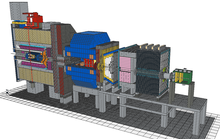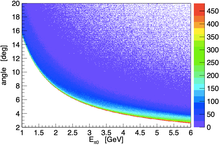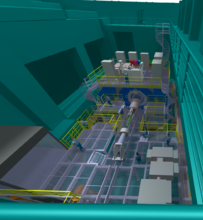The "Outstanding Achievement Award 2020" goes to three groups. The awardees are: Outreach Committee, EMC Software Team and our three Coordination Engineers
 The Outreach Committee consisting of Miriam Kümmel, Michael Papenbrock, Mustafa Schmidt and Rebecca Seip has given strong momentum to the outreach activities and their efforts will help spreading knowledge and interest about PANDA in society.
The Outreach Committee consisting of Miriam Kümmel, Michael Papenbrock, Mustafa Schmidt and Rebecca Seip has given strong momentum to the outreach activities and their efforts will help spreading knowledge and interest about PANDA in society.
The presentation of their work during the Collaboration Meeting 2020/3 was an impressive demonstration of what they have achieved so far: Development of PANDA models in 3D, Lego and virtual reality. This outreach session was very well received, and has, in combination with the aforementioned initiatives given momentum to the outreach activities.
The picture shows a CAD PANDA model consisting of about 10.000 Lego bricks, which was generated by a special Lego planning tool.
 The groups from Institute of High Energy Physics, CAS, Beijing University of Science and Technology of China, Hefei and Nankai University, Nankai led by Sun Shengsen did extraordinary work on updating the EMC offline software. The work includes implementing the latest geometries, updating the digitization algorithms according to the test beam data and firmware algorithms, as well as work on the reconstruction software and the calibration algorithms.
The groups from Institute of High Energy Physics, CAS, Beijing University of Science and Technology of China, Hefei and Nankai University, Nankai led by Sun Shengsen did extraordinary work on updating the EMC offline software. The work includes implementing the latest geometries, updating the digitization algorithms according to the test beam data and firmware algorithms, as well as work on the reconstruction software and the calibration algorithms.
The contributers - Guangshun Huang, Chunxiu Liu, Dong Liu, Qing Piu, Sun Yankun, Guang Zhao and others – paved the way to a better PANDAroot software for the simulation and reconstruction of the PANDA electromagnetic calorimeter.
The picture is a Monte Carlo study of the angle between two photons detected by the EMC coming from a $\pi^0$ decay as a function of the pion energy.
 The three engineers performed a significant concerted effort to work out the detailed specifications of the PANDA infrastructure regarding support structures and supply infrastructures. Daniel Glaab, Stefan Koch and Jost Lüning designed support structures in particular cover platforms, support frames, rails and movements systems, installation devices and supply infrastructure in particular covers drag chains, cable trays, electrical power distribution and grounding, cooling water and technical gases, everything with the whole lifetime of PANDA in mind, from installations to data taking periods and the maintenance phases in-between.
The three engineers performed a significant concerted effort to work out the detailed specifications of the PANDA infrastructure regarding support structures and supply infrastructures. Daniel Glaab, Stefan Koch and Jost Lüning designed support structures in particular cover platforms, support frames, rails and movements systems, installation devices and supply infrastructure in particular covers drag chains, cable trays, electrical power distribution and grounding, cooling water and technical gases, everything with the whole lifetime of PANDA in mind, from installations to data taking periods and the maintenance phases in-between.
The detailed design serves as a crucial input for the common fund investments for infrastructure of PANDA and has been a central part of the recently submitted TDR to the FAIR ECE. It brings the collaboration in the position to plan the tendering of the construction of the required infrastructure components.
The resulting detailed technical report was praised by experts at FAIR and from CERN reviewing the document for the level of detail and expertise.
The picture is a CAD drawing of our detector in the maintenace position with all support platforms in place.
Congratulations to all awardees. You have done an outstanding job!




